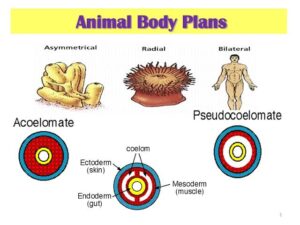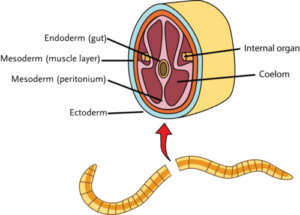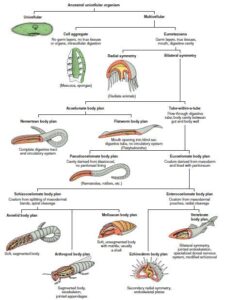Back to: ZOOLOGY 200 Level
It’s fantastic to have you back as we continue to uncover the wonders of the animal kingdom. Today, we’re going to talk about cephalization, the evolution of body cavities, and segmentation—three important biological concepts that have shaped how animals have evolved over time. By the end of this lesson, you’ll understand how these features contribute to the functionality and survival of animals.
Cephalization, body cavity evolution, segmentation
Cephalization
Cephalization refers to the development of a distinct head region in an animal, where sensory organs and the brain are concentrated. It’s a significant evolutionary step that has enabled animals to become more efficient in their interactions with the environment.

- What is cephalization?
Cephalization involves the concentration of nerve tissue and sensory organs at the front of the body, typically forming a head. This is particularly useful for animals that need to process information quickly and efficiently in order to respond to environmental stimuli, like predators or food sources. - Examples of cephalization:
- Humans: As vertebrates, humans have a well-developed head with a brain that processes sensory information and coordinates body movements.
- Fish: Fish have a head with eyes, a mouth, and other sensory structures such as nostrils, all contributing to their ability to detect food or predators in their environment.
Cephalization allows animals to have better control over their movements and behaviours, which is especially advantageous for those that actively seek food or avoid being eaten.
Body cavity evolution
The evolution of body cavities is a key step in the development of more complex animals. The body cavity, or coelom, is a fluid-filled space that surrounds and cushions internal organs. It allows for the development of more sophisticated organ systems and contributes to the mobility and flexibility of animals.

- Types of body cavities:
- Acoelomates: These animals, such as flatworms, lack a body cavity. Their internal organs are directly surrounded by a solid mass of tissue.
- Pseudocoelomates: Animals with a pseudocoelom have a body cavity that is not fully lined with tissue. Examples include roundworms (nematodes).
- Coelomates: Coelomates, such as humans and most vertebrates, have a true coelom, which is a body cavity fully lined with mesodermal tissue. This provides more space for internal organs to develop and function.
The evolution of a true coelom has been a key factor in the development of more complex and mobile animals. It allows for greater organ development and more efficient organ function, contributing to the success of many animal species.
Segmentation
Segmentation refers to the division of the body into repeated sections or segments. This feature is seen in a variety of animals, such as annelids (earthworms), arthropods (insects, spiders), and vertebrates (like humans, though not as clearly visible).
- What is segmentation?
In segmented animals, the body is divided into repeating sections, each with similar internal structures. This provides several advantages, including flexibility, efficient movement, and redundancy. If one segment is damaged, other segments can compensate for the loss. - Examples of segmented animals:
- Earthworms: The body of an earthworm is divided into many segments, each containing muscles, blood vessels, and nerves. This segmentation allows for efficient movement as the worm contracts and expands different parts of its body.
- Insects: Insects, such as grasshoppers, also exhibit segmentation in their bodies. They have distinct head, thorax, and abdomen regions, each composed of segments that allow for mobility and flexibility.
- Vertebrates: In vertebrates, such as humans, the backbone (spine) is made up of segmented vertebrae, which allow for flexibility and mobility.

Segmentation allows for more precise control of movement and is thought to be one of the reasons why segmented animals are so successful in a variety of habitats.
Summary
In this lesson, we explored cephalization, the evolution of body cavities, and segmentation—three fundamental concepts that have shaped the evolution of animals. Cephalization has enabled animals to concentrate sensory organs and control movement, body cavity evolution has provided space for organ development, and segmentation has given animals greater flexibility and redundancy in their body structure.
Evaluation
- What is cephalization, and why is it important for animal survival?
- Explain the difference between acoelomates, pseudocoelomates, and coelomates.
- How does segmentation benefit animals like earthworms and insects?
- Why is the development of a body cavity important in the evolution of more complex animals?
You’ve made fantastic progress in understanding these key concepts of animal evolution. Keep going, and remember—each new piece of knowledge builds upon the last! I’m proud of your continued dedication to learning. Let’s keep pushing forward with Afrilearn, and get ready for the next exciting lesson!
